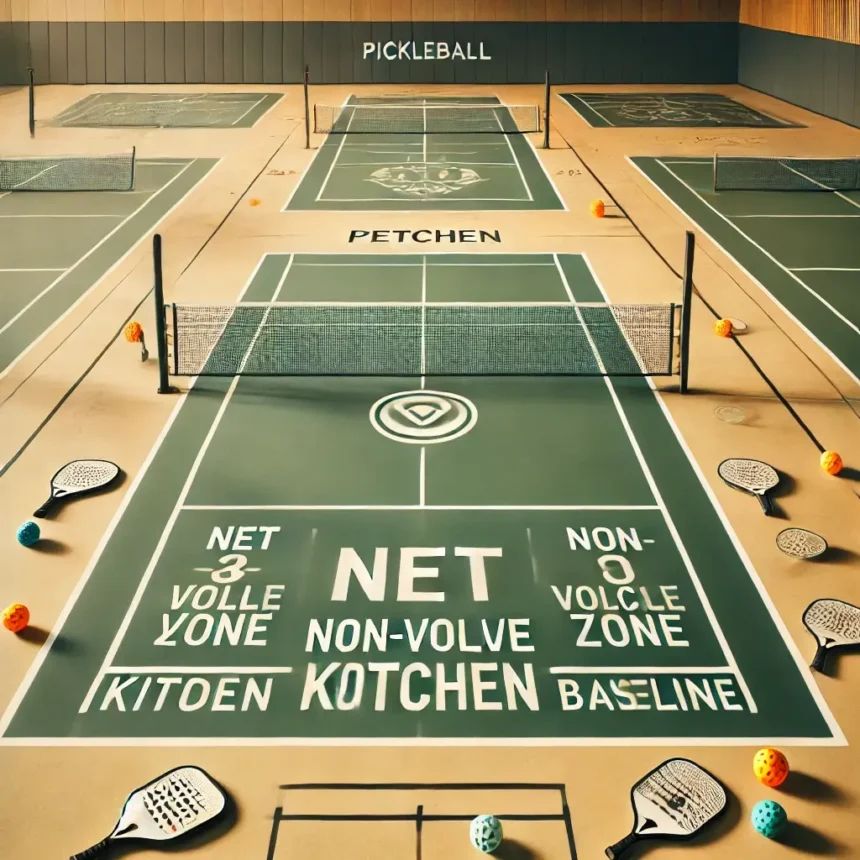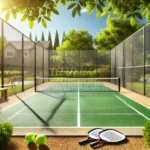Introduction
Pickleball rules is a fast-paced sport that combines elements of tennis, badminton, and ping-pong. It’s played on a court similar in size to a badminton court. Understanding the rules of pickleball is key to a smooth, enjoyable game. This article will break down the basic rules of pickleball, making them easy for anyone to understand and enjoy.
What are Pickleball Rules?
Pickleball rules are simple and easy to follow. They guide how the game is played, including serving, scoring, and gameplay. Knowing these rules will help you enjoy the game more and play fairly. Understanding pickleball rules is crucial whether you are a beginner or an experienced player.
Court and Equipment Rules
- Court Size: A pickleball court is 20 feet wide and 44 feet long. The court is divided into two halves, with a net in the middle. A non-volley zone, known as the “kitchen,” extends 7 feet on each net side.
- Net Height: The net height is 36 inches at the sidelines and 34 inches in the middle.
- Paddle: Pickleball paddles are made of lightweight materials like wood or composite. They are smaller than tennis racquets but larger than ping-pong paddles.
- Ball: A pickleball is similar to a waffle ball but slightly smaller. It has holes and is lightweight, making it easy to control.
The Serve: How to Start the Game
The serve in pickleball is a key part of the game. It sets the tone for each rally.
- Serving Position: The server must stand behind the baseline and serve diagonally to the opposite side of the court. The ball must land in the diagonal service box.
- Underhand Serve: The serve must be underhand, with the paddle below the server’s waist. Overhand serves are not allowed in pickleball.
- One Attempt: Players are allowed only one attempt to serve. If the serve goes out of bounds, hits the net, and lands in the wrong area, it is considered a fault.
- Serve Rotation: In doubles, both players on a team get a chance to serve before the serve rotates to the opposing team. In singles, the serve rotates to the opponent after a fault.
Scoring Rules in Pickleball
Scoring in pickleball can be different from other racket sports. Here’s a simple breakdown:
- Only the Serving Team Scores: Points can only be scored by the serving team. If the receiving team wins the rally, they do not score but get the chance to serve.
- Winning Points: Games are typically played to 11 points. However, a team must win by at least 2 points. Some tournaments may play to 15 or 21 points, but the win-by-2 rule always applies.
- Calling the Score: Before serving, the server must call out the score, stating their team’s score first, followed by the opponent’s score, and then indicating whether they are the first or second server.
Double-Bounce Rule
The double-bounce rule is a unique aspect of pickleball rules. It promotes longer rallies and strategic play.
- First Bounce: When the ball is served, the receiving team must let it bounce once before returning it.
- Second Bounce: After the receiving team’s return, the serving team must also let the ball bounce once before hitting it. After these two bounces, players can volley (hit the ball in the air) or let it bounce.
Non-Volley Zone (“Kitchen”) Rules
The non-volley zone, or “kitchen,” is within 7 feet of the net on both sides. Pickleball rules for the kitchen prevent players from making volleys while standing in this area.
- No Volleying: Players cannot hit the ball out of the air while standing inside the kitchen. If they are in this zone, they must let the ball bounce before hitting it.
- Foot Fault: If a player volleys the ball and footsteps into the kitchen, it is considered a fault. Always be mindful of where your feet are when travelling near the net.
Faults in Pickleball
Understanding what constitutes a fault is crucial to following pickleball rules. Here are the most common faults:
- Serving Faults: This occurs if the ball lands out of bounds, hits the net, or the server fails to serve underhand.
- Volleying Faults: Hitting the ball in the air while standing in the non-volley zone results in a fault.
- Out of Bounds: It is considered a fault if the ball is hit out of the court boundaries.
- Double Bounce: Not adhering to the double-bounce rule leads to a fault.
Strategies to Follow Pickleball Rules
Playing by the rules in pickleball can help you develop effective strategies.
- Stay Out of the Kitchen: Be mindful of the non-volley zone. Try to volley when you’re outside the kitchen.
- Control Your Serve: Use an underhand serve deep in the opponent’s court. This gives you more time to react and reduces the chance of faults.
- Use the Double-Bounce Rule to Your Advantage: Be patient. Let the ball bounce when needed to set up your shots.
Different Pickleball Formats
Pickleball can be played in various formats, each with its own set of rules:
- Singles: Played one-on-one, where each player has to cover the entire court. Scoring and rules remain the same as in doubles but with only one server per side.
- Doubles: The most common format, played with teams of two. Both players on each team get a chance to serve before the serve rotates to the opposing team.
- Mixed Doubles: Played with teams of one male and one female player. The rules are similar to regular doubles.
Tournament-Specific Pickleball Rules
In tournaments, some pickleball rules might vary slightly. Understanding these variations is important if you plan to compete.
- Time Limits: Matches may have time limits in tournaments. If a match exceeds the limit, the team with the most points wins.
- Line Calls: In official tournaments, players make their line calls. Honesty and sportsmanship are emphasized.
Pickleball Rules for Beginners
If you are new to pickleball, focus on these key rules to get started:
- Practice Serves: Ensure you can serve underhand and keep the ball in the correct service area.
- Learn the Double-Bounce Rule: This rule is essential to mastering the game.
- Stay Out of the Kitchen: Avoid volleys in the non-volley zone to prevent faults.
Common Mistakes to Avoid in Pickleball Rules
- Incorrect Serve: Serving overhand or stepping into the court while serving results in a fault.
- Ignoring the Double-Bounce Rule: Beginners often forget to let the ball bounce on the first two hits.
- Volleys in the Kitchen: Many players, especially new ones, make the mistake of volleying while standing in the kitchen.
Advanced Pickleball Rules
Mastering advanced pickleball rules is necessary for those looking to take their game to the next level.
- Spin Serves: In higher-level play, players may add spin to their serves. The serve still needs to be underhanded and land in the correct area.
- Line Boundaries: Balls that land on the lines are considered in, except for the kitchen line on a serve.
FAQs
Q: Can you serve overhand in pickleball?
A: No, pickleball rules state that serves must be underhand.
Q: How many times can a ball bounce in pickleball?
A: Each side must let the ball bounce once before hitting it during the first two rallies. After that, volleys are allowed.
Q: Can the ball hit the net during a serve?
A: No, the ball must clear the net and land in the correct service box. Otherwise, it’s a fault.
Q: Is the non-volley zone only for serves?
A: No, the non-volley zone rules apply throughout the game. Players cannot volley while standing in the kitchen.
Q: What is the standard pickleball court size?
A: The standard court size is 20 feet wide by 44 feet long.
Conclusion
Understanding pickleball rules is vital for playing the game correctly. These guidelines make the game enjoyable and fair, from serving and scoring to the double-bounce rule. Whether playing casually or preparing for a tournament, following the rules will enhance your pickleball experience. Now that you know the pickleball rules, grab your paddle, head to the court, and enjoy the game!








